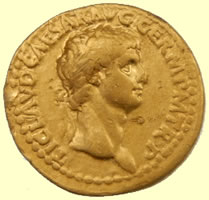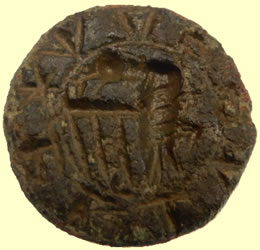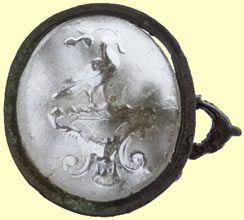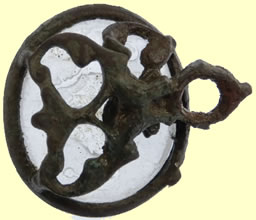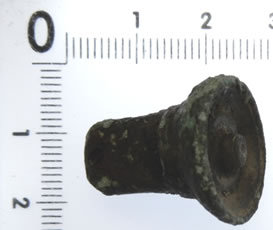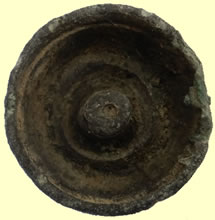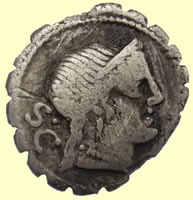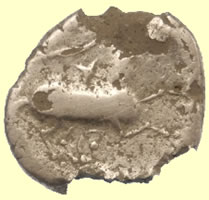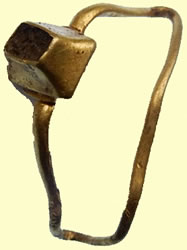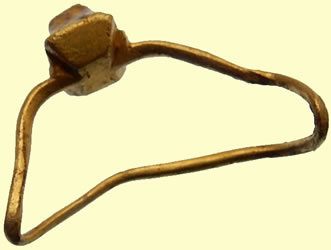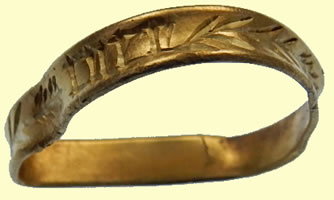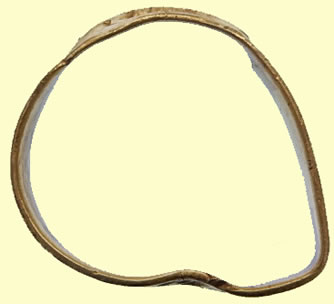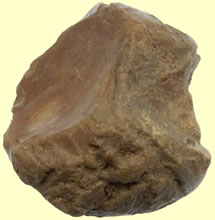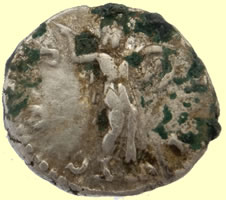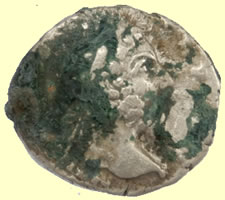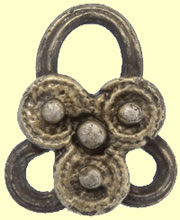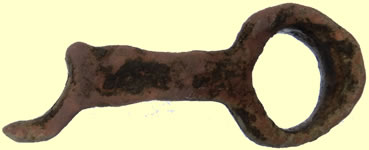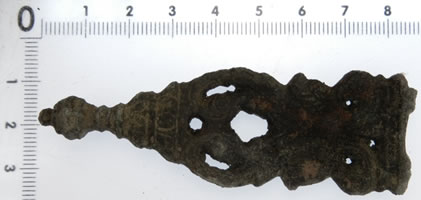

Metal detecting holidays in England with the World's most successful metal detecting club.
Twinned with Midwest Historical Research Society USA
2018 April Finds page |
Roman gold coin send for ID 19mm,7.70g Well, even though Roman gold is way out of the orbit in which I normally travel, I see absolutely no reason to question its authenticity. I presume you know this is an aureus of Claudius. It’s obviously clear enough overall that there should be no doubt about the legends, but for the sake of form: My congratulations to all involved – well found! |
|||
13thC seal matrix Bird facing right with double long beak Legend PRIVE SV (I am private) Sent to our seal expert for his views It's another PRIVE SV, Chris. HAMP-EA9E0$ and SF-470BCD are particularly close with the upraised and spread wing. If you simple search "matrix bird PRIVE SV" you'll find parallels. In this case I found it was much clearer simply reversing the original than looking at the impression -- sometimes it's like that! regards, Malcolm |
|||
  |
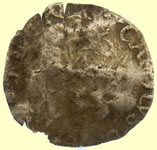 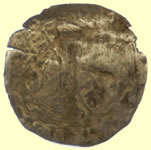 |
||
1279 Edward 1st hammered silver penny Obv + EDW **** DNS hYB Rev CIVI/TAS/DVN/** Durham mint |
1624 Charles 1st hammered silver penny | ||
  |
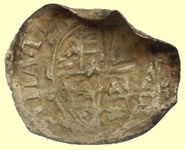  |
||
| 1247 Henry III hammmered silver voided long cross penny | 1624 Charles 1st hammered silver penny | ||
  |
  |
||
1377 - 99 Richard II hammered silver half penny - Type 1n Obv +RICARD.REX.ANGL Rev CIVI/TAS/LON/DON London mint |
1327 Edward III hammered silver groat Rev S/EBO/ - York mint |
||
  |
 |
||
| 1697 William III milled silver sixpence | c 1800 Napoleonic Wars East Essex Militia button - sent for date confirmation and recording The East Essex Militia were formed in 1759 and became the Essex Rifles Militia in 1853 during this period they had five styles of known button, this one is not listed yet. Unlisted on http://asahelena.wixsite.com/militarybuttons/buttons-e-f
Apologies for the delay in reply. This East Essex Militia style would date to c1790-1800. There is however no conclusive dating evidence for this style but has to be pre 1830 with GR script. The unit itself was raised in 1759 and there is at least two earlier designs to the unit known |
||
 |
 |
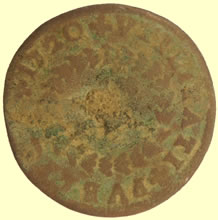 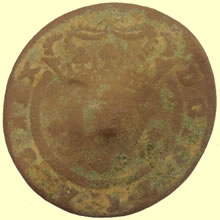 |
|
Post Medieval cast copper alloy single loop buckle frame. 1500-1650 AD |
19thC Coast guard button | Huge 1720 Continental copper coin Portugal 10 ReisJoão VObverseLettering: ReverseLettering:
|
|
 |
 |
|
|
| 19thC Royal Regiment of Artillery button | 16thC Tudor clothing fastener | Undiagnostic silver finger ring | |
 |
|||
| 1st to 4thC Roman bronze coins | |||
 |
  |
||
| 2 - 18thC crotal bells | Georgian horse harness bell | ||
 |
 |
  |
|
| Georgian silver pendant | Georgian lead tobacco jar lid handle | Medieval long cross hammered silver penny fragment | |
1351-52 Edward III hammered silver groat- Series C annulet in third qtr on reverse - annulet under bust Obv +EDW**** Rev CIVI/TAS/LON/DON - London mint |
|||
 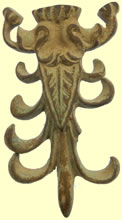 |
  |
||
| 1500-1700 mount | 17thC decorated sword hanger | ||
  |
  |
||
1485 Henry VII hammered silver half penny - Cross furchee - Open crown im.Pheon: 'brushed hair' type Obv HENRIC DI GRA REX A Rev CIVI/TAS/LON/DON - London mint
|
1569 Elizabeth 1st hammered silver sixpence | ||
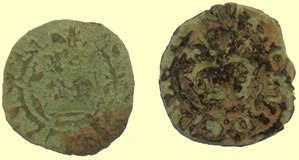 |
  |
||
| 1634 Charles 1st hammered copper rose farthings | 1279 Edward 1st hammered silver long cross penny Obv +EDWAR**** Rev **I/TAS/DVN - Durham mint |
||
 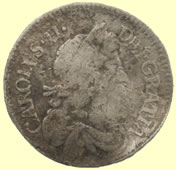 |
  |
||
| 1679 Charles II milled silver three pence | 1199 John hammered silver short cross half penny - Class 5b Obv *ENRICVS REX Rev REV/ON C- Moneyer Andreu of Canterbury mint |
||
  |
  |
||
| Huge Georgian pot leg with ball and claw foot | Huger medieval bronze pot leg | ||
  |
 |
||
1199 John silver short cross half penny - Class 5b Obv *ENRICVS ** Rev ON.CICE - Chichester mint |
Georgian silver button 'C.GRIFFITH LONDON' |
||
  |
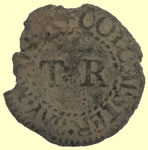 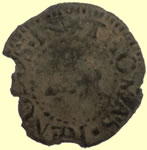 |
||
| Medieval hammered silver long cross penny- quadrefoil at centre of reverse cross - York mint | 17thC Thomas Reynold baymaker of Colchester hammered copper trade farthing | ||
Neat glass Georgian fob seal matrix |
|||
 |
 |
  |
|
| Georgian watch winder | RN Capt / Commander - 1787 RN Lieutenant - 1787 |
1842 Victoria milled silver sixpence | |
Roman style tent peg
|
|||
|
 |
||
| Victorian silver brooch | 18thC crotal bell | ||
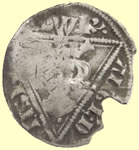 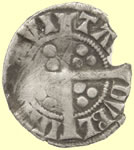 |
  |
||
Irish 1279-1301 Edward 1st hammered silver penny Obv EDWR ANGL DNS HYB Rev CIVI/TAS/DUBL/INIE - Dublin mint |
1369-77 Edward III hammered ilver penny - Post Treaty period - quadrefoil at centre of reverse cross Obv *** L FRAN Rev TAS/EBO - York mint |
||
1634-5 Charles 1st hammered silver shilling - Bell mint marl (12 pence) |
|||
Large 60mm dia medieval lead bird feeder |
|||
  |
  |
||
1344 Edward III hammered silver farthing - Type 1 Obv EDWARD***** Rev CIVI/TAS/LON/DON - London mint |
1280 Edward 1st hammered silver penny - Cross 1 - Class 3cd Obv + EDWR ANGL' DNS hYB Rev CIVI/TAS/LYN/C *** Lincoln mint |
||
 |
 |
 |
|
| 15thC lead token | 16thC Tudor button | 16thC Tudor clothing fastener | |
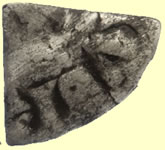  |
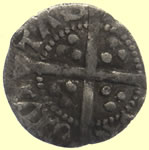 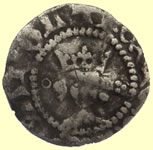 |
||
| 1247 Henry III hammered silver voided long cross farthing | 1413 -22 Henry V hammered silver half penny - Type 10 Annulet to left and trefoil to right by hair Obv + hENRIC x Rex X:ANGL' Rev CIVI/TAS/LON/DON - London mint |
||
  |
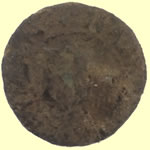 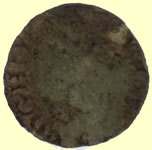 |
||
1247 Henry III hammered silver voided long cross farthing Rev EIN - Bury St Edmunds mint |
17thC Henry Lamb of Colchester hammered copper trade farthing | ||
 |
|||
18thC 11th Regiment of foot button - pewter XI regiment Hanmer's (11th/Devonshire) Regiment Remaining in Ireland until 1703, the Devonshires then joined John Churchill, the Duke of Marlborough's, army in Holland, where they assisted to capture the fortress of Huy and the city of Limburg, then held by the Spaniards. The Regiment's next campaign was in Portugal in 1705, and, after a visit to England, again in 1708. In 1711 the 11th formed part of the unsuccessful expedition against the French in Canada. Except in 1715 and 1719, where the 11th gave a good account of itself in Scotland, the Regiment's history is uneventful for some thirty years. In 1719 Spanish troops landed in Ross-shire, and were joined by the Scottish clans of the neighbourhood. The 11th formed part of a small force which, charging with the bayonet, dispersed Spaniards and Highlanders, won the Battle of Glenshiel, and broke the insurrection. |
|||
  |
  |
||
| 18th Dutch lead bale seal | 1834 Willim IV milled silver sixpence | ||
 |
 |
 |
|
| WWII Royal Air Force button | 1550 - 1700 buckle | WWI Royal Army service corp lapel badge | |
 |
 |
  |
|
| 17thC lead token | WWII Royal Air Force button | 1608 AD Hans Schultes III, looks like 'Turbanded bust' German Jetton. | |
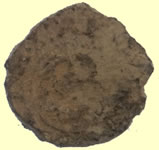  |
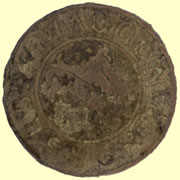  |
||
| 1634 Charles 1st hammered copper rose farthing | 19thC Insurance Token Obv Mutual Rev Wagoon. Horses |
||
 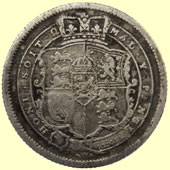 |
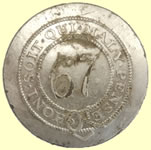 |
||
| 1816 George III milled silver shilling | An officers example to the 67th who were known as the 67th (South Hampshire) Regt of Foot from 1782-1881. c1790-1820 67 within inner strap reading HONI SOIT QUI MAL Y PENSE.
THE 67th REGIMENT OF FOOT The 1st South Hampshire Regiment was formed in 1782 of the old 67th Foot. The regiment won acclaim in India and was commemorated with the Royal Tiger on the regimental badge. They later became the 2nd Battalion of the Hampshire Regiment |
||
 |
 |
  |
|
| Victorian Royal Engineers button | WWI Royal Army medical corp | 1770's 18 shillings coin weight Ibv S 18 |
|
  |
  |
||
| 2ndC Roman bronze coin | Georgian bell trade weight | ||
  |
 |
||
| Georgian mount | 18thC toy cannon | ||
 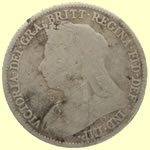 |
 |
||
| 1896 Victoria milled silver sixpence | Capt / Commander - 1774-1787 RN Master & Mate - 1787-1807 RN Surgeon - 1787-1805 |
||
  |
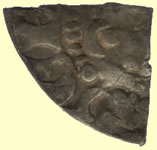  |
||
| 15thC Angel coin coin weight | 1247 Henry III hammered silver voided long cross farthing | ||
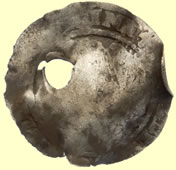 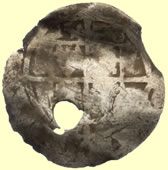 |
 |
||
| 1578 Elizabeth 1st hammered silver half groat | 20thC 'Mother' brooch | ||
  |
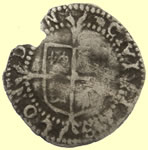 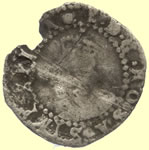 |
||
| 1584-6 Elizabeth 1st hammered silver half groat- Escallop mint mark | 1592-5 Elizabeth 1st hammered silver penny - Tun mint mark | ||
  |
 |
 |
|
| Interesting spiked copper ball ? | Georgian silver thimble | 1500-1700 mount | |
  |
  |
||
| Victorian gold cufflink - Initials CM | 1279 Edaward 1st hammered silver long cross penny | ||
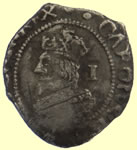  |
  |
||
| 1641-3 Charles 1st hammered silver penny - mintmark 2 dots | 1279 Edward 1st hammered silver penny Obv EDWAR ANGL DNS hYB Rev CIVI/TAS/LON/DON - London mint |
||
Classic Roman mounts
Very unusual Roman bronze mount - possible lynch pin with hole through pin
|
|||
 |
 |
 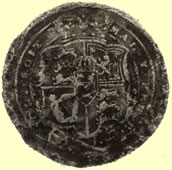 |
|
| Georgian watch winders | 17thC crotal bell | 1819 George III milled silver shilling | |
  |
  |
||
| Continental billion silver coin | 1908 Edward VII milled silver sixpence | ||
  |
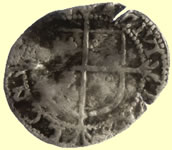  |
||
| Early medieval lead token | 1582-3 Elizabeth 1st hammered silver penny - bell mint mark | ||
 |
 |
||
| 18thC crotal bell | 1500-1650 buckle | ||
11,000 BC flint scraper |
|||
  |
|||
| Victorian pill box | |||
 |
 |
 |
|
Post-medieval copper alloy double-looped buckle frame, both loops trapezoidal. The very distinctive form is as Whitehead 2003 no. 527 c.1620 - c.1680 |
1500-1700 mount | Large toy lead elephant | |
  |
 |
 |
|
| 1696 William III milled silver sixpence | Georgian button | 15thC lead token | |
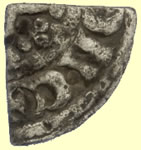 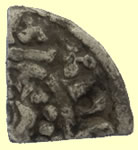 |
  |
||
1216 Henry III hammered silver short cross farthing Rev ON.C+ - Canterbury mint |
1873 Victoria milled silver three pence | ||
 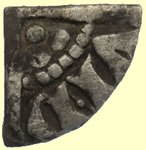 |
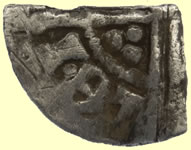 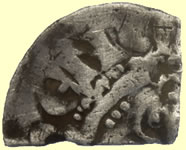 |
||
1247 Henry III hammered silver voided long cross farthing Rev VND - London mint |
1247 Henry III hammered silver voided long cross farthing Rev LE.I - Carlise mint |
||
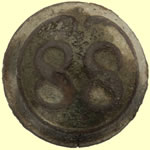 |
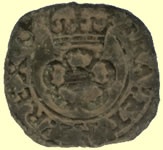 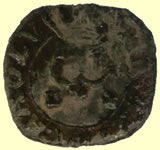 |
||
| French Infantry Button 88th Line Regiment Circa 1803-1814 |
1634 Charles 1st hammered copper rose farthing | ||
 |
  |
||
| 15thC casket key | Alexander II 1214-49 Scottish hammerd penny Obv ALEX*** |
||
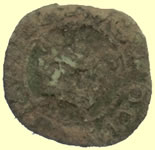 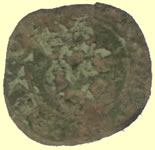 |
  |
||
| 1634 Charles 1st hammered copper rose farthing | Georgian watch winder | ||
 |
 |
 |
|
| 1550-1700 buckle | 17thC lead token | Georgian button | |
  |
  |
||
| 1814 Russian lead bale seal | 1943 George V milled silver sixpence | ||
|
|
||
| Victorian silver clasp | Victorian silver trim piece | ||
  |
  |
||
1501-1521 Leonardo Lauredan, Doge Rev: LAVS TIBI SOLI (Thee Alone be Praised). Haloed figure of Christ holding a cross. Obv: LE LAV DVX S M V (Leonardo Lauredan, Doge. St Mark of Venice.) Doge kneeling before Saint Mark. |
1788 George III Worchester visit medallion Obv George III Dei Gratia Rev Worchester August 6th 1788 |
||
Victorian gold sovereign scale arm
|
|||
Cleaned up stunning BC Roman silver coin sent for ID As it turns out, there are very few trigas (3-horse hitch) on Roman coins of any type – only a few among the Republicans which run heavily to quads- and bi-gas. It’s C. Naevius Balbus, 79 B.C. Also, the “SC” on the obverse is quite unusual as well, indicating that the silver for the issue was approved – probably as a huge emergency issue to raise and equip an army during the civil war disturbances at the time of Sulla’s dictatorship – by a specific act of the Senate. Not particularly early, and definitely not rare, but in the Republican silver series, it is a unique combination of all of these somewhat lesser-seen elements: serrate, triga, “SC”. The “CCV” on the reverse is a control mark and variable.
|
|||
Cunobelin wild type gold contemporary forgery stater, VA 1933-1. VA 1933 type recorded although there are some minor variations in the size of the star over the horse (Van Arsdell splits them into small and large, but it's not always easy to decide where small ends and large begins!). Probably somewhere around the middle of his reign, perhaps c. 20 - 25 AD'.
|
|||
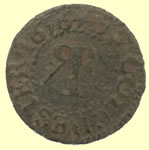  |
 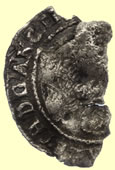 |
||
1656 Richard Rich of Colchester Essex hammered copper trade farthing Ref Norweb 1216 |
1578 Elizabeth 1st hammered silver three pence | ||
 |
  |
||
| 18thC cotal bell | Roman bronze amphora pendant | ||
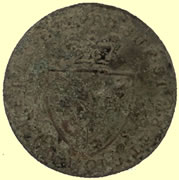 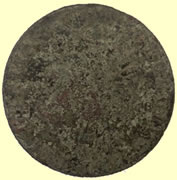 |
|
||
| George III gold guinea gaming token | Georgian spur | ||
Disclaimed treasure fixed gold ring and sapphire reset Unique ID: ESS-77F7D3 Object type certainty: Certain
A Medieval gold ring with rectangular bezel. The band would have been circular in shape but is now distorted. It has a circular section and is very narrow, thickening slightly before the bezel. The bezel is rectangular in plan and hexagonal in section, with a rectangular opening on the outer face. Within the opening is a blue stone setting. Dimensions:diameter (distorted): 21.99 mm; thickness of bezel: 5.02 mm; weight: 1.84g. |
|||
Disclaimed treasure fixed gold ring Stunning 14thC medieval gold ring 1.26g, 20mm Lombardic script possibly Latin A medieval gold finger ring. The object has a flat band, slightly concave and with an engraved decoration on the outer surface. There is an inscription in black letter style writing, which reads tout mon coer (all my heart). Engraved between each word is a plant, resembling a palm or fern. The ring is slightly distorted with a small crack visible on the internal surface. Dimensions: diameter (distorted): 17.26 mm; thickness: 0.84 mm; weight: 1.23g |
|||
 |
 |
 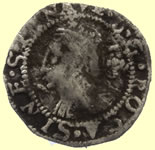 |
|
| 1500-1650 buckle | 1500-1700 mount | 1561 Elizabeth 1st hammered silver penny | |
 |
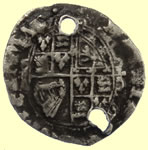  |
||
| 17thC key | 1625 Charles 1st hammered silver penny | ||
  |
  |
||
| Georgian pendant - glass stone with leaf motiff | Mid 4thC Roman bronze coin sent for ID It’s easy to tell you the type and even, probably, the mint here. What I can’t tell you with certainty is who among the members of the “House of Valentinian” issued it – the obverse legend is completely missing due to edge-chipping. So is the reverse legend, but the type is pretty obvious – it’s a SECVRITAS REIPVBLICE restored centenionalis. Most likely to be, in this order: Although it may not be from the same mint (several of the Western mints used privy-mark systems which, among other marks, would have placed an F in the left field) this is the same basic type – and definitely from Siscia: http://www.stoa.org/gallery/album82/20_Valens_SER_SIS?full=1
|
||
Great eyeball find - 450 million year old fossil Sea Urchin Echinoid
Huge lead hanging seal matrix - circa 15thC Partial legend |
|||
  |
 |
||
Medieval hammered silver long cross penny Obv DNS hYB+ **** Rev TAS/C *** |
Georgian buttons | ||
Roman silver hoard coin No35 - sent for ID and reported as hoard addendum to museum 18mm, 3.11g |
|||
Roman silver coin - needs 'cooking'to remove crust 16mm,3.12g |
|||
 |
 |
 |
|
| Huge 1704 Queen Anne trade weight - London mark | 17thC clothing fastener | Post medieval cast copper alloy two piece buckle C1650-1725 |
|
70BC Morini Celtic gold qtr - sent to PAS for recording 1.39g,11mm |
|||
10-40 AD Cunobelin Celtic gold qtr stater - sent to museum for recording 1.32g,11mm |
|||
1stC BC to 1stC AD Celtic cosmetic wode grinder |
|||
16thC Tudor gilded silver clothing fastener - reported to museum as treasure
|
|||
Interesting gilded hollow copper horse filled with lead ?? |
|||
  |
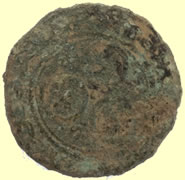 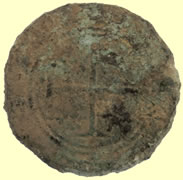 |
||
1296 -1318 Edward 1st hammered silver penny - pellet on breast - Clss 2c Obv **** DNS hYB+ Rev VILL/ABE/REV/VICI - Berwick mint |
Louis XII (1497-1515)French Jetton Rev Simple cross patty Obv Three circles of Tournai |
||
 |
 |
  |
|
| 15thC lead token | Royal fuseliers button | 2ndC Roman bronze coin | |
 |
 |
  |
|
Description: Letters KO either side of crown above Staffs knot Category:English Infantry Militia Type of button: Convex ; Metal: Copper Alloy gilded.Backmark:; Date: 1805-c1853. |
Georgian buckle | 1854 Victoria milled silver three pence | |
 |
 |
 |
|
| 1500-1700 mount | 5th Dragoons guards buttons - Crimean war period - unrecorded in any ref book - | ||
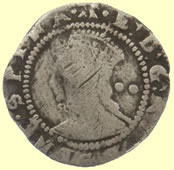  |
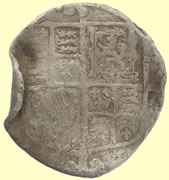 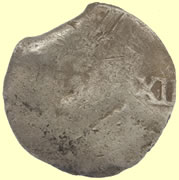 |
||
| 1582 -1584 Elizabeth 1st hammered silver half groat - 'A' mint mark | 1627 Charles 1st hammered silver shilling (12 pence) | ||
  |
 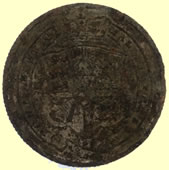 |
||
| Georgian gilded mount | 1816 George III milled silver sixpence forgery | ||
 |
 |
 |
|
| 18thC Royal Artillery button | Medieval mount | Georgian key | |
 |
 |
 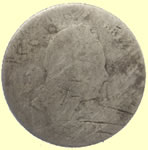 |
|
| 19thC livery button | Georgian watch winder | 1837 William III milled silver four pence | |
 |
 |
||
| THE ESSEX REGIMENT Formed in 1881 from The 44th. (East Essex) Regiment of Foot (1st Battalion) & The 56th. (West Essex) Regiment of Foot. (2nd Battalion). Nicknames:- "The Two Fours", "The Little Fighting Fours", "The Pompadours" & "Saucy Pompeys. | RFA- Royal Fleet Auxiliary regiment lapel badge | ||
 |
 |
  |
|
| 16thC Tudor clothing fastener | Georgian button | 1655 Henry Lamb of Colchester Essex hammered copper trade farthing | |
  |
 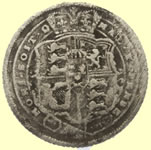 |
||
| 17thC button | 1820 George III milled silver sixpence | ||
  |
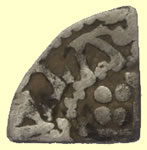 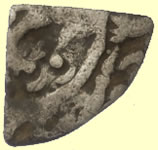 |
||
| 1625 Cahrles 1st hammered silver half groat | 1216 Henry III hammered silver short cross farthing | ||
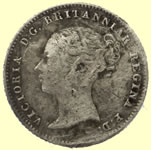  |
  |
||
| 1838 Victoria milled silver four pence | 1696 William III milled silver shilling | ||
  |
  |
||
| 1929 George III milled silver shilling | 1922 George III milled silver sixpence | ||
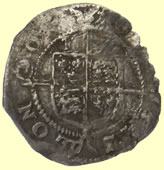 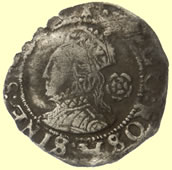 |
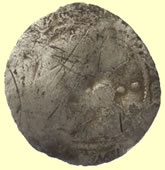 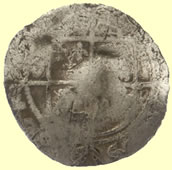 |
||
| 1572 - 1573 Elizabeth 1st hammered silver three pence - Ermine mint mark | 16thC Elizabeth 1st hammered silver half groat | ||
|
  |
||
| C10thC Saxon harness cheek piece | 1945 George VI milled silver half crown (30 pence) | ||
 |
  |
||
| 1500-1650 buckle | 16thC Elizabeth 1st lead trade weight - Crown E cipher | ||
Huge post medieval mount |
|||
  |
  |
||
| Mid 4thC House of Constantine Roman bronze coin | 1377 Richard II hammered silver half penny OBV +RICARDxREXx:ANGL** Rev CIVI/TAS/LON/DON - London mint |
||
Roman bronze foot |
|||
  |
  |
||
Unknown 17thC coin weight - possible foreign issue Obv bust facing left Rev II D XX Not in Withers British coin weights ref book |
1216 Henry III hammered silver short cross farthing Rev ON.C+ - Canterbury mint |
||
  |
  |
||
| 17thC hammered copper trade farthing | French copper- alloy Jeton 15th Obv Shield of France bearing three fleur de lys | ||
  |
  |
||
| 1770's George III gold guinea coin weight - S21 - 21 shillings | 1625 Charles 1st hammered silver penny | ||
  |
  |
||
| 1625 Charles 1st hammered silver penny | 16thC Elizabeth 1st hammered silver half groat | ||
850BC Bronze Age socketed Axe head |
|||
  |
  |
||
| Unknown Asian silver coin | Victorian "Cumberland Jack" Token 1837
These are a common find in boxes of household junk, old drawers, and accumulations and collections of coins. They are made of brass, probably as a satyrical gaming token. When Queen Victoria acceded to the British throne, she could not assume the Hanoverian throne, as this was restricted to male succession only. Her relative the Duke of Cumberland therefore succeeded in her place. Apparently he was quite unpopular, and this jeton was issued as a humorous comment on his departure from the British Isles. Obverse Crude young head portrait of Queen Victoria, facing left, with her hair in her familiar "bun". This portrait is very similar to that which appears on the young head sovereigns of Victoria, with the legend (inscription). VICTORIA REGINA Reverse |
||
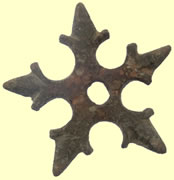 |
  |
||
| 15thC spur rowel | 18thC apothecary weight | ||
Roman lead disc |
|||
  |
  |
||
| 4th C House of Constantine Roman bronze coin | 17thC Low countries Burgundian rider coin weight | ||
  |
  |
||
| 17thC Ambrose Sutton of Coggeshall Essex hammered copper farthing | Georgian trade weight - Crown G cipher London | ||
  |
 |
||
| 1852 Louis Napoleon Bonapart - the President of the republic medallion | 17thC William 1st trade weight - Crown W cipher | ||
  |
 |
||
| 1649 Commonwealth hammered silver penny | 76th French regiment button Circa 1803-1814 |
||
  |
|||
| 1603- 4 James 1st hammered silver half groat- Thistle mint mark | |||
Previous Feb 2018 Finds pagePrevious March 2018 Finds page |
|||
 |
|||

